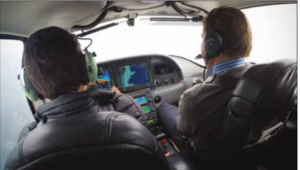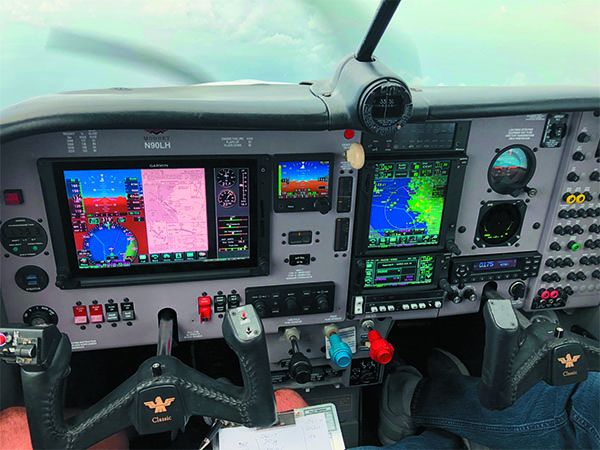From the front lines, I’ve watched integrated avionics—retrofit and forward-fit—energize the avionics market for the past 15-plus years. The amount of technology packed into this equipment continues at the pace of the personal computer in its heyday. The vast amount of information now available should allow us to aviate, navigate and communicate with a higher degree of safety.
However, the statistics show that technology has played only a small part in improving safety, and in some cases, contributes to accidents. Moreover, our capability to process technology depends on the understanding of the systems, repetitive use and human factors. That’s not easy.
QUICK CHECKOUT: NOT
Here’s a lesson worth learning from. Back in the early days of TAA (technically advanced airplanes) I had the opportunity to get “checked out” (I’ll use that phrase loosely) in a new Diamond DA40 equipped with the Garmin G1000 flight deck. I received some ground instruction from another CFI who knew the system about as we’ll as I did—and this was my first time laying eyes on it.
During the ground portion of the training that took place in the cockpit, external electrical power was not applied properly, and the battery was run flat. This allowed some time to grab lunch and watch a video the instructor provided. The 2.2 hours of flying I did that day proved that the CFI needed more training in the aircraft or at least to have watched the video. My “checkout” allowed me to simply rent the aircraft, and any further training would be on my own.
It wasn’t until the New Mexico Civil Air Patrol acquired their first Cessna 182T NAV III package in the summer of 2006 that my glass cockpit training really began. CAP sent two flight instructors to Cessna to receive their initial FITS (FAA Industry Training Standards) scenario-based instruction. At least one of these CFIs had sensory overload the entire week and was reminded that it still flies like a 182.
The NM Wing prepared a transition program for its pilots that consisted of handouts for home study, PowerPoint classroom presentations on the system, and of course, the flying and human factors aspect. I found the technology exciting and initially beyond my capabilities to comprehend. I’m not the sharpest tool in the shed, so for me to understand the G1000 took considerable effort. I was determined to learn this exciting, capable and complex design and found that the best way to learn it was to teach it.
I was not a CFI yet, but CAP encouraged all pilots to contribute where they could. My primary source was a third-party G1000 training book that breaks the system down to its most simple functions and allows the pilot to understand the “knobology” of the tasks. Like the other pilots, I took a topic each month and shared what I learned with the squadron. I started with the HSI—a simple display with a lot more to it than meets the eye. Initially, we taught each other at a basic level, because there are so many other functions that had to be put on the back burner until our brains were ready to absorb more.
I also did IFR training flights at night and found myself way behind the curve, often disconnecting the autopilot because the airplane was not doing what I expected it to do. The KAP140 autopilot was a whole other ballgame for me. It took about 30 hours of challenging flying to finally stay ahead of the airplane and make the G1000 and autopilot work for me. (Remember that number—30 hours.)
The initial New Mexico CAP G1000 transition program took 37 pilots through the course and successful completion of their Form 5 checkrides over two years. Only two pilots failed to master the G1000.
ENGINEERING EYES

I started a new job as a senior buying analyst with an avionics company in 2012. One of my first tasks from the president was to acquire an aircraft with Garmin’s new GTN 750 and GTN 650 navigators. I leased a beautiful 1999 Mooney Bravo so equipped. The goal was to get key company engineers familiar with the technology being sold by the industry sales leader—Garmin. The GTNs proved intuitive and a great complement to a complex airframe. In fact, these units proved themselves so we’ll that I was able to make long IFR flights into busy Southern California. Keep that in mind when going it on your own with a new avionics package. Do you think your level of its understanding will make you safer or more of a risk in IMC? Answer truthfully.
This venture led to more flying opportunities within the company. I experienced the Cirrus SR22 equipped with Avidyne’s Entegra Release 9 system that again took about 30 hours of flying to comprehend fully. The company Cessna 182 was equipped with a dual Aspen System that I enjoyed and which proved quite intuitive once I knew where to start looking for hidden information. Unfortunately, the airplane also had the ill-fated KSN 770 navigator that I never understood—even after 30 hours. Many of these hours were flown with the head of flight-test up front with me, an FAA DER in one of the rear seats and another test pilot occupying the other rear seat. All flights were recorded with an action cam.
One notable moment happened while flying the localizer to Runway 3 in Roswell, New Mexico. It’s a back course known as the Widow Maker. I wasn’t fully understanding the KSN 770, and that raised my blood pressure while trying to perform the series of tasks required to fly the missed approach and hold. This frustrated our company test pilot as he tried to coach me through it. I stated what I expected to see and advised on my actions based on what didn’t happen. It wasn’t until the GoPro video was viewed during the post-flight that the crew understood my thought process and apologized for making fun of my flying. Get a thorough demo of any major system by someone who knows it inside out before buying it. Will you be able to make it do what you want it to do when the workload is piling up? Trust your instincts.
FALSE SENSE OF SECURITY
I’ve been fortunate to have flown over 55 types of aircraft in my 38 years of flying, equipped with a wide variety of avionics and autopilots. My current job with an avionics sales/installation/FAA Repair Station provides a direct connection to pilots and their airplanes daily. Many of my customers are 4000-hour-plus pilots who know their airplane we’ll and do a lot of research on what equipment they want installed. However, there are those customers who can’t name the avionics in their airplane … “it’s a K something or Cessna something.”
It doesn’t matter how long a pilot has been flying or how familiar they are with the aircraft when it comes to avionics upgrades. Some pilots pick up their airplanes and tell me they’re already familiar with what was installed, and off they go. The majority study the pilot’s guide that I provide prior to the installation, but until they go through the motions in flight, it can be a challenge.
I provide instruction to most of my customers after an avionics upgrade and observe the sensory overload experienced when operating their new equipment. I sometimes get surprised at the lack of basic flying skills exhibited. Fortunately, most of the pilots are quite disciplined. As one example, the addition of an Aspen EFD1000 Pro, a new navigator or two simple Garmin G5s paired to a GFC 500 autopilot may not seem overwhelming to those of us who fly them daily, but it introduces enough technology to humble the best pilot. I’ve been in their shoes and know that it all comes down to the individual and their ability to comprehend new technology while flying the aircraft.
My last bit of advice to my customers is to fly with another pilot— preferably one who knows the avionics or, at the very least, can keep some eyeballs outside during the “heads down period” of learning. The goal is staying ahead of the airplane and not having to use the phrase, “What’s it doing now?”
It doesn’t take much with a high workload in IMC for our brains to go to mush. Let’s train and fly more often so we can use these complex avionics to reduce our workload in the high-pressure scenarios as a measure of safety (risk mitigation) rather than a distraction.
Contributor TJ Spitzmiller is a CFI and works with Sarasota Avionics in Florida.


